Access Item Analysis Reports
Access Item Analysis Reports
Pearson offers four Item Analysis reports that focus items, and domains or strands for performance. They provide percentages and levels, and provide a breakdown of earned credit by any one of the following:
- Student
- Item
- Standard
- Domain
Depending on your project, you may see links to view the items, student responses, and rubrics.
Prerequisites
- Confirm your role under your name and your district or school in the Organization dropdown. If you have access to multiple projects or organizations, click each dropdown to select the one(s) you want to view.
- Tests must have been previously scored. Pearson provides these reports based on responses received from your class. This report only reflects those provided responses.
Step-by-Step
From the main menu, click (or tap) Reports.
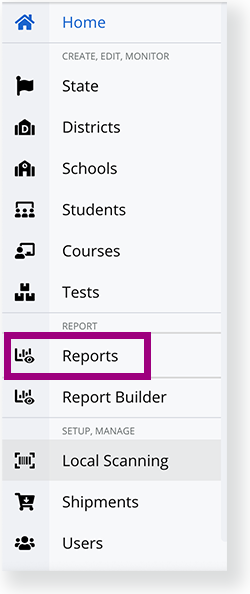
Select your administration.
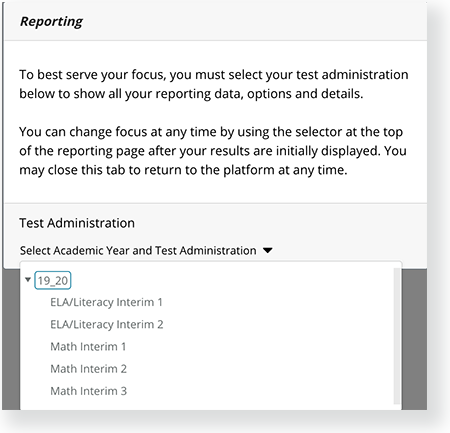
On the Assessment Results page, you can use the Administration Selector to change the at administration any time. Next to the Administration Selector, you can click the Report Options icon
 to alter how the system presents the data.
to alter how the system presents the data.Click the more options icon
 until you can select Tests.
until you can select Tests.
- If you have access to more than one organization, first click the more options icon to select Districts.
- Then, select Schools, and then Classes or Tests. You can also search within each organizational level.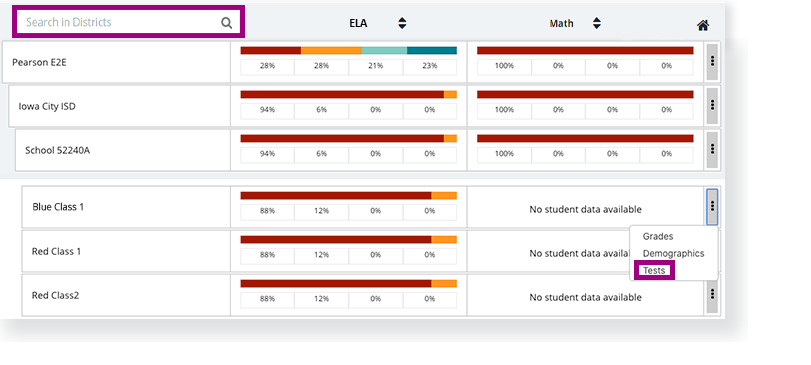
You can view data in two possible ways:
- Click a colored section of the test or class bar graph, and then either a performance level or View Performance Details.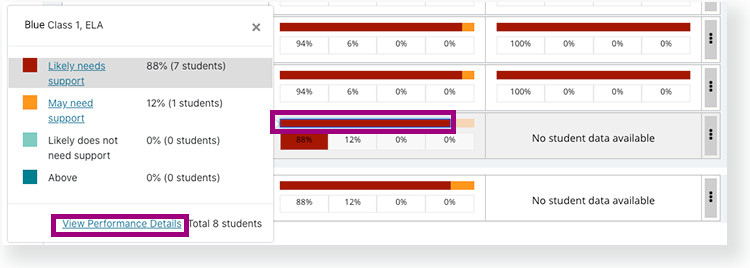
- Click a percentage or count. Note that the values may appear as percentages or raw scores, depending on your program.
See the callouts below for details on options at the top of each reporting page.
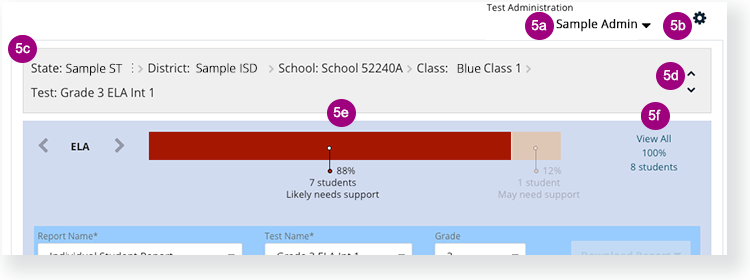
5a - You can click the Test Administration dropdown to change administrations anytime.
5b - Click the Report Options icon (![]() ) to toggle between Performance Levels or Achievement, and Percentages or Counts.
) to toggle between Performance Levels or Achievement, and Percentages or Counts.
5c - Breadcrumbs at the top of the page indicate each organization you clicked through to get to the report.
5d - You can click the arrows to go back to the prior page.
5e - The bar graph contains performance color indicators and counts/percentages for each. You can click a portion to view only students at each level.
5f - You can click View All 100% to view all students at all performance levels.
6. Click the Report Name* dropdown to select one of the following
- Item Analysis by Student
- Item Analysis by Item
- Item Analysis by Standard
- Item Analysis by Domain
7. Click the Test Name* dropdown to select the test and the Grade dropdown to select the grade.
See the callouts in each tab below for more details on each report. Each report may contain trait scoring, depending on your program.
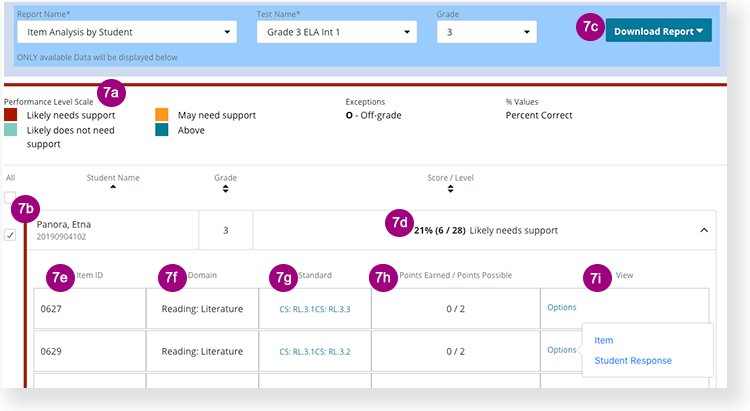
7a - The Performance Level Scale measures student performance. Labels and colors may vary, depending on your program.
7b - Select the checkbox in the student's row to select that student.
7c - After you select the student, you can click Download Report to download a PDF or a CSV of the report.
7d - The student score/level includes his or her performance percentage or points earned.
Click the arrow at the end of the row to expand the report.
7e - Each item has a unique ID.
7f - The domain indicates the subject area.
7g - You can click the standard to see its details.
7h - Indicates points earned out of possible points.
7i - You can click Options and Item, Student Response, or Rubric (when available).
Below is an example of a Student Response.
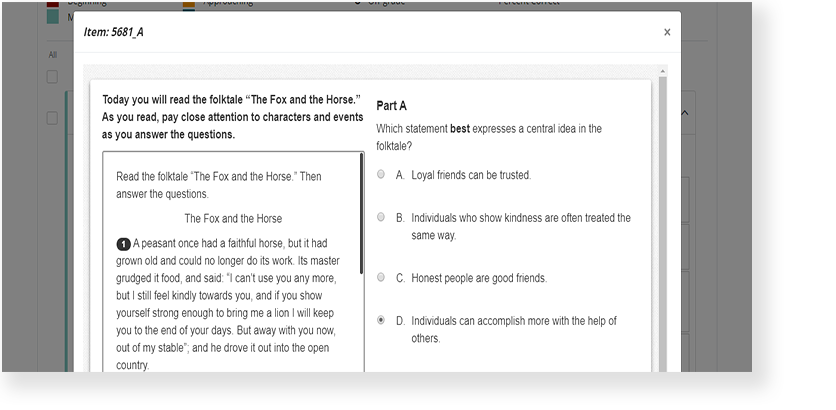
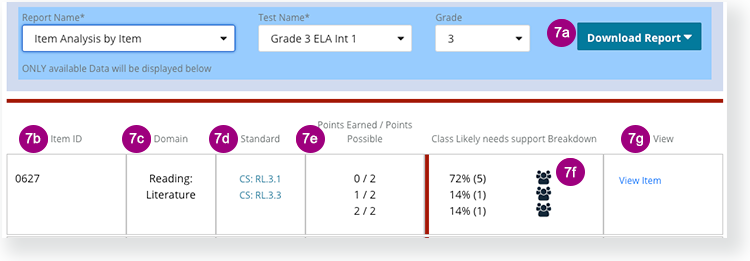
7a - You can click Download Report to download a PDF.
7b - Each item has a unique ID.
7c - The domain indicates the subject area.
7d - You can click the standard to see its details.
7e - Indicates points earned out of possible points.
7f - You can click the Class Breakdown icon (![]() ) to view students included in that percentage.
) to view students included in that percentage.
7g - You can click View Item to see that item. For unreleased items on high-stakes tests, Not Available appears in that row.
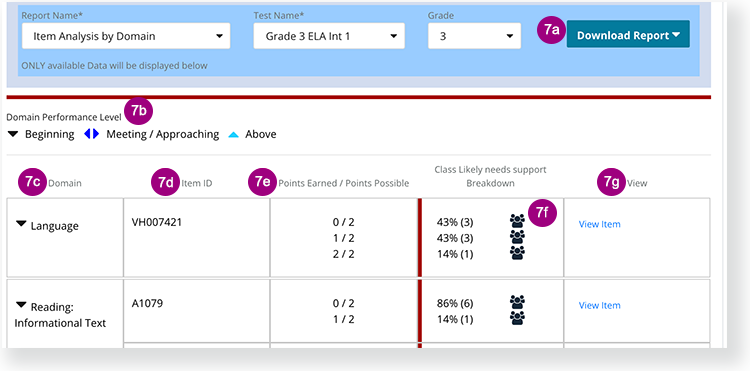
7a - You can click Download Report to download a PDF of the report.
7b - The Domain Performance Level measures performance on each domain. Labels and colors may vary, depending on your program.
7c - The domain indicates the subject area.
7d - Each item has a unique ID.
7e - Indicates points earned out of possible points.
7f - You can click each Class Breakdown icon (![]() ) to view students included in that percentage.
) to view students included in that percentage.
7g - You can click View Item to see that item. For unreleased items on high-stakes tests, Not Available appears in that row.
Trait Scoring
Reports may contain trait scoring for open-response items. Depending on your program, you may see correlated standards listed for the overall item or for each item trait. In the example below, the report displays overall performance on the item, with each trait and correlated standards, as well as performance on each trait.
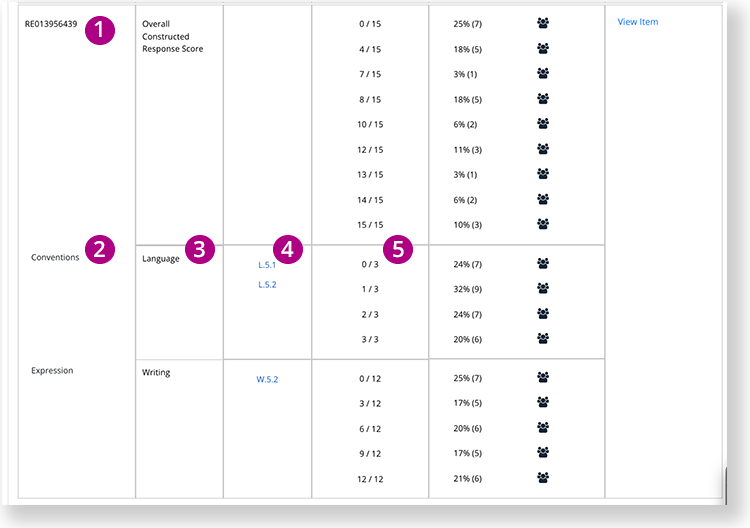
1 - The Item ID appears for the overall item.
2 - Conventions and Expression are the traits for this overall item.
3 - Domains indicate subject areas for these traits. In this example, Language and Writing domains align with these traits.
4 - Standards can appear in the Item ID row or in the trait/domain row, depending on your program. This example displays standards (for example, L.5.1) aligned with each trait rather than the overall item.
5 - Performance indicators for traits appear in the same column as they do for other item types.